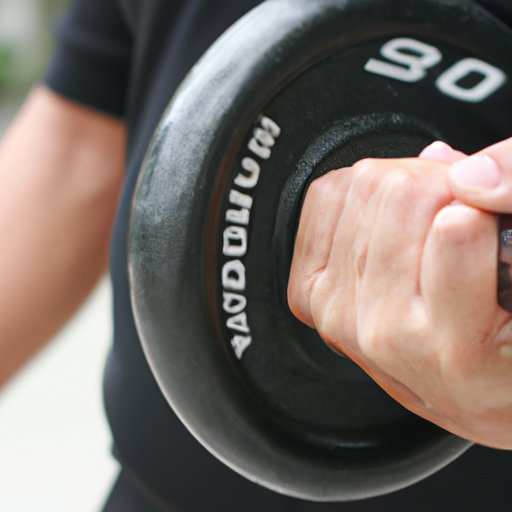
Introduction
When people think about burning calories, they often associate it with cardiovascular exercise such as running or cycling. However, weight lifting is often overlooked and misunderstood as a form of exercise for weight loss and calorie burn. In this article, we aim to debunk the common misconception that weight lifting does not burn as many calories as cardio and explore the science behind it. We also provide practical tips and strategies for maximizing calorie burn during weight lifting workouts.
Unlocking the Truth: How Weight Lifting Burns Calories
Weight lifting increases metabolism, which means that the body is burning more calories even at rest. This is because when muscles are worked through resistance training, they require more energy to repair and grow, and this process can continue for up to 48 hours after the workout. This is known as the afterburn effect. Hence, weight lifting makes the body burn more calories for a longer time as compared to cardiovascular exercise.
Not all weight lifting exercises are equally effective for calorie burn. Compound movements like squats and deadlifts, which work multiple muscle groups, are more efficient than isolation exercises like bicep curls or tricep extensions, which work only one muscle group at a time. Hence, incorporating compound movements into your weight lifting routine is a great way to maximize calorie burn.
Weight Loss Wonder: The Benefits of Combining Weight Lifting and Cardio for Calorie Burn
Combining weight lifting with cardiovascular exercise is a highly effective way to burn calories and achieve weight loss. Cardiovascular exercise helps to elevate the heart rate and burn excess calories, while weight lifting increases metabolism and muscle mass. This combination leads to a greater overall calorie burn and weight loss. For instance, circuit training alternates between strength exercises and cardio exercises and is an excellent way to combine both types of exercise.
Another popular form of exercise that combines both cardio and weight lifting is high-intensity interval training (HIIT). HIIT alternates between high-intensity cardio exercises and short bursts of weight lifting exercises. This form of exercise is particularly effective for burning calories even after the workout is over.
How Many Calories Can You Really Burn While Weight Lifting? Breaking Down the Numbers
The number of calories burned during weight lifting depends on multiple factors such as the intensity of the workout, muscle mass, and body weight. On average, a 30-minute weight lifting session can burn between 100-300 calories. For instance, a person weighing 150 pounds can burn about 224 calories during a 60-minute weight lifting session, whereas an individual weighing 200 pounds will burn approximately 298 calories during the same session.
While weight lifting does not burn as many calories as cardiovascular exercise, it is still an effective way to burn calories and achieve weight loss. Moreover, since weight lifting increases metabolism, it can help burn more calories in the long run even when you are not exercising.
Maximizing Calorie Burn During Weight Lifting Workouts: Tips and Strategies
To maximize calorie burn during weight lifting workouts, it is essential to increase intensity and target major muscle groups. Incorporating supersets and drop sets, which involve performing two or more exercises back-to-back without rest, is an effective way to increase intensity and calorie burn. Focusing on major muscle groups like chest, back, and legs is recommended as these large muscle groups require more energy and hence lead to a greater calorie burn.
Incorporating other forms of exercise during weight lifting workouts can also help keep the heart rate up and increase overall calorie burn. For example, performing jumping jacks or high knees in between sets is an excellent way to increase intensity and calorie burn. Finally, proper technique and form are essential for effective calorie burn. Proper technique leads to the right muscle activation, which, in turn, means that you are working out harder and hence burning more calories.
Weight Lifting for Weight Loss: How to Incorporate Strength Training into Your Fitness Routine for Maximum Calorie Burn
If you are new to weight lifting, it is essential to start with lighter weights and focus on proper technique. Gradually increase weights and incorporate compound movements, supersets, and drop sets as your fitness level improves. Creating a workout plan that combines both weight lifting and cardio exercises is recommended, and monitoring progress through weight and body measurements can help to keep you motivated.
Finally, nutrition and recovery are essential components of weight loss and calorie burn. Proper nutrition, including a balanced diet and adequate protein intake, is necessary for muscle recovery and growth. Recovery is essential for muscle growth and repair and hence must be incorporated into your fitness routine. This includes getting enough sleep, taking rest days, and performing stretching exercises to prevent injury and soreness.
Conclusion
Weight lifting is an effective way to burn calories and achieve weight loss. It increases metabolism, builds muscle mass, and can lead to a greater overall calorie burn. Combining weight lifting with cardiovascular exercise is an excellent way to maximize calorie burn and achieve weight loss. Incorporating compound movements, supersets, drop sets, and other forms of exercise during weight lifting workouts can increase intensity and calorie burn. Proper technique, nutrition, and recovery are essential components of weight loss through weight lifting.
There are many benefits to weight lifting, and it is an integral part of a well-rounded fitness routine. We encourage readers to experiment with different types of exercise and workout routines and incorporate weight lifting into their fitness schedules. With consistency and dedication, weight lifting can provide immense benefits for overall health and well-being.




